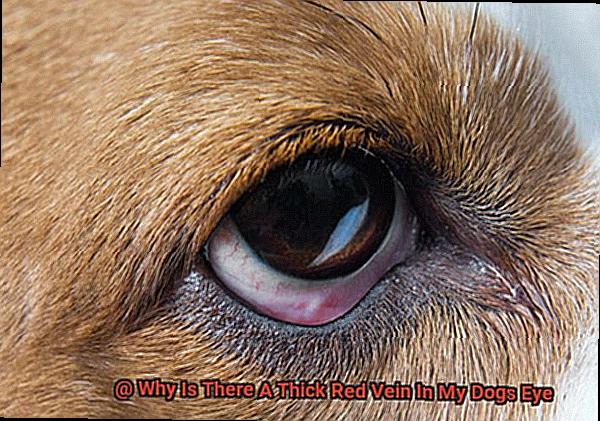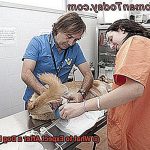Why Is There A Thick Red Vein In My Dogs Eye?
Have you ever noticed a thick, red vein in your dog’s eye? Don’t worry, it’s normal! This scleral venous sinus can be found in most dogs.
In this post, I’ll explain why there is a thick red vein in your pup’s eye, what it does for their wellbeing, and how to keep it healthy. We’ll also look at the differences between breeds and how they influence these veins. By the end of this post, you’ll have a better understanding of why there is a thick red vein in your dog’s eye and how to keep it healthy.
If you’re wondering about this strange occurrence, don’t fret! Read on to learn more about this fascinating phenomenon and how to keep your pup safe and healthy.
Why Is There A Thick Red Vein In My Dogs Eye?
Contents
- 1 Why Is There A Thick Red Vein In My Dogs Eye?
- 2 Signs and Symptoms to Look Out For
- 3 Diagnosis and Treatment Options
- 4 How to Prevent Thicker Red Veins in Dogs
- 5 When to See a Vet for a Thick Red Vein in Your Dog’s Eye?
- 6 Natural Remedies for Treating Thick Red Veins in Dogs
- 7 Common Questions About Thick Red Veins in Dogs
- 8 Conclusion
This may be an indication of an underlying health issue that must be addressed. Here, we’ll discuss the common causes of thick red veins in dogs and what you should do if you encounter this symptom.
Conjunctivitis
Conjunctivitis, which is an inflammation or infection of the tissue that lines their eyelids, is the most common cause of thick red veins in dogs. Allergies, burns, tumors, and foreign bodies are also potential causes. In some cases, however, the reason for the veins may remain unclear.
Allergies
Allergies can cause inflammation in the eye and lead to a thick red vein. Trauma to the eye can also cause bleeding from broken blood vessels and result in a thick red vein. Tumors may place pressure on nearby blood vessels, leading to a thick red vein as well. Lastly, foreign bodies such as dust or dirt particles may irritate the eye and result in inflammation that causes a thick red vein.
Glaucoma
Glaucoma or uveitis are other conditions that may lead to a thick red vein in your dog’s eye. If you suspect any of these disorders, it is essential to seek veterinary care immediately for proper diagnosis and treatment.
If you observe any signs of thick red veins in your dog’s eyes, please consult your veterinarian right away.
Signs and Symptoms to Look Out For
Has your pup’s eye taken on a thick, red vein? It’s important to be aware of the signs and symptoms so they can get the care they need.
The most visible sign of a thick red vein is, of course, the vein itself. Redness, swelling, discharge, cloudiness, and a yellowish tinge are all possible symptoms.If it is painful, they may squint or rub at the area.

Left untreated, vision loss and even blindness can occur. That’s why it’s essential to seek medical attention right away. Antibiotics, anti-inflammatory medications, or surgery to remove any blocked vessels or foreign bodies may be used depending on the underlying cause. In some cases, laser treatments can help reduce inflammation and improve blood flow.
If your dog has any of these symptoms, don’t delay; call your veterinarian immediately.
Diagnosis and Treatment Options
If your dog has a thick red vein in its eye, it is essential to seek specialist help immediately. An ophthalmologist can diagnose the condition and determine the best treatment options for your pet.
The severity of the vein will influence the treatment plan. Medications may be prescribed to reduce inflammation, reduce pain, and shrink the size of the vein. Laser therapy can also be used to reduce its size and improve blood flow. In more severe cases, surgery may be needed to repair any damage caused by the vein or remove it altogether.
The prognosis for dogs with this condition is good if diagnosed and treated early on. However, if left untreated, it could lead to more serious problems in the future.
How to Prevent Thicker Red Veins in Dogs
It’s important to take the necessary steps to ensure that their eyes remain healthy and strong. Here are some ways to help prevent thicker red veins in dogs.
Regular eye exams
Regular eye exams should be a priority for any pupparent. Taking your dog for regular checkups with their veterinarian can help detect any issues with their eyes or veins early on, enabling you to work together with your vet to create a treatment plan that is best for your pup.
Proper nutrition
Proper nutrition is key when it comes to preventing thicker red veins in dogs. Make sure they’re getting all the vitamins and minerals they need through a balanced diet and plenty of fluids throughout the day. This will help keep their eyes healthy and prevent those pesky red veins from forming.
Keep Away From Environmental Irritants
It’s also important to keep your pup away from environmental irritants such as smoke, dust, or pollen, which can cause inflammation of the eyes and veins.
Additionally, be mindful of any activities or objects that may cause trauma to your pup’s eyes, such as sticks or toys, and use protective eyewear when playing or running in areas with sharp objects or debris, which can cause injury to the eyes and veins.
Regular grooming
Regular grooming is also essential for maintaining eye health in dogs. Make sure you’re cleaning their fur around their eyes on a daily basis with a warm cloth or cotton ball to remove any dirt or debris present in the area, which can contribute to thicker red veins forming.
If recommended by your vet, you may also need to use eye drops on your pup to reduce inflammation and irritation that could lead to thicker red veins forming in the future.
When to See a Vet for a Thick Red Vein in Your Dog’s Eye?
It is essential to seek veterinary attention immediately.
A deep red vein in your dog’s eye could be indicative of a serious underlying condition, such as glaucoma, tumors, or infections. If left untreated, these conditions can lead to blindness or worse.
Your veterinarian will be able to examine your dog and determine the cause of the thick red vein.
Depending on the cause, they may suggest various treatments, including antibiotics, surgery, or medications.
Natural Remedies for Treating Thick Red Veins in Dogs
Thick red veins in dogs are a common occurrence and can be treated with natural remedies.
Start by applying a warm compress to the affected area. This will help reduce the appearance of the vein and boost circulation in the area. Herbal supplements such as chamomile tea or ginkgo biloba can also be beneficial for reducing inflammation and improving circulation.
Eye drops containing natural ingredients like witch hazel or chamomile can provide relief from irritation and reduce redness.
To keep your pup’s eyes healthy, make sure to clean the eye area regularly with a gentle cleanser to prevent infection and further irritation of the skin.
Common Questions About Thick Red Veins in Dogs
Have you ever spotted large, red veins on your pup’s skin?
These veins, known as telangiectasias, are more common in dogs than you might think. You may be wondering what causes them and whether they are something to worry about. Here are the answers to some of the most common questions about thick red veins in dogs.
Are thick red veins in dogs a cause for concern?
Generally speaking, no. These veins typically don’t pose any health risks and don’t require any surgery. However, if your pup is exhibiting other signs of illness, such as vomiting or loss of appetite, it’s important to visit the vet to rule out any underlying medical issues that might be causing the telangiectasia.
What causes thick red veins in dogs?
Telangiectasias can be caused by a range of conditions, including allergies, hormonal imbalances, and even aging. In some cases, they may also be due to a genetic predisposition or a skin injury.
Are there any treatments for thick red veins in dogs?
In most cases, medical intervention isn’t necessary because these veins rarely cause any health problems. However, if your dog is suffering from an underlying medical condition or if their telangiectasias are causing them pain or distress, your veterinarian may recommend laser therapy or topical medications to reduce their appearance.
What can be done to prevent thick red veins in dogs?
Sadly, there isn’t much that can be done to stop telangiectasias from occurring because they can have so many different causes. However, you can help keep your pup healthy by feeding them a balanced diet and making sure they get regular exercise and checkups with the vet.
Conclusion
It’s normal to feel concerned when you notice a thick, red vein in your dog’s eye.
But with the right information and care, you can help keep your pet healthy and safe. This blog article has outlined the causes, signs, diagnosis, and treatment of thick red veins in dogs.
We’ve also discussed how to prevent them from forming in the first place and when it’s important to seek veterinary help.




